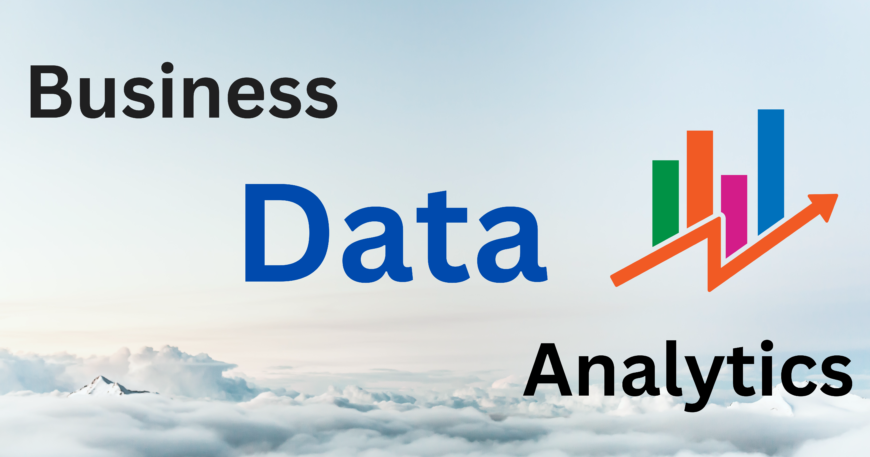6 Reasons why data analysis is important for Business
Introduction to Data Analysis in Business
Data analysis has been identified as one of the foundational building blocks of contemporary business. Today, nearly every transaction markedly generates data: customer behavior, sales, social media interactions, and supply chain activity. Ultimately, how well analytics are done with this data is going to be the core basis on which businesses will be able to successfully compete, make smart decisions, and grow.
But what really does data analysis involve, and how does it work to further businesses? Data analysis is best defined as a process of methodical application of statistical and logical techniques to describe, summarize, and compare data. In other words, it draws out useful information toward the bottom-line management decision, giving life essentially to modern business strategy. If you’re just getting started, you might want to check out this in-depth description of IBM-What is Data Analysis.
Understanding Data Analysis
Data analysis is more than number-crunching; it involves the transformation of raw data into actionable insights. Since businesses can’t keep pace with the data-driven world, it should be ensured that they understand the different facets of data analysis. It is well-structured and aids the organization in detecting trends, recognizing inefficiencies, and making predictions, thus guiding strategy formulation.
Key Benefits of Data Analysis in Business
1. Informed Decision-Making
Data analysis gives business the insights necessary to make informed decisions. An analysis of past performance and existing trends helps businesses better predict the future. Therefore, forecasting can be done more correctly and risk management can also be more effective-resource utilization is also done in a more productive manner. Data-driven decisions will lead the firms away from intuition and guesswork toward evidenced-based strategies. For more on how data drives business decisions, the Harvard Business Review offers a compelling discussion.
2. Enhanced Customer Understanding
By analyzing data, businesses will get to understand their customers’ behaviors, preferences, and needs and, thus, be able to customize their products, services, and marketing strategies. Enterprises that allocate resources to understanding their customers can offer highly specific offerings and products and enable much more active engagement and satisfaction. This is the idea behind the use of personalized marketing strategies; you can learn more about the topic from this enlightening Forbes article.
3. Increased Efficiency and Productivity
It is followed by the data analysis, which points the firms toward areas that need improvement in their operations. The analysis of workflow data, supply chain data, and employees’ performance data can indicate bottlenecks for companies. Helping them reorganize such processes to save on costs with more productivity means retaining operational capacity with fewer resources. With data-driven insights into managing supply chains, they will be in an even better position to reduce the costs and enhance delivery performance. For data-driven supply chain optimization, see in detail this McKinsey article.
4. Competitive Advantage
Today, as companies move to establishment based on the availability of data analysis in secure competitive advantage, it means that every organization that interprets data and adapts quickly to changes in the market is performing better than its competitors. Data analysis in business makes the identification of market trends, consumer preference, and emerging opportunities faster and quicker against competition. For example, through data analysis, an organization may anticipate changes that might shift consumer behavior in terms of new trends immediately and exploits them to their advantage ahead of competition.
5. Risk Management
Data analysis is considered to be the key driver in identifying and mitigating risk. Businesses, by analyzing historical patterns, can point out patterns indicative of fraud, financial stability, operational weaknesses, etc. It thus becomes proactive in preventing risks before they affect businesses and contributes to the protection of assets, reputations, and future growth.
Financial data analysis can critically reduce risks in investment and resource allocation. Right financial forecasting and actionable insights make financial planning robust. For further understanding of the topic, read how data analysis helps business performance in the article entitled “Financial Analysis” by Corporate Finance Institute.
6. Strategic Planning and Forecasting
It is only through correct data analysis that strategic planning and forecasting will be effectively catered for. Market trend analyses, economic indicators, and internal data on performance enable a firm to plan strategies in such a way that they can then have specific long-term goals. Accurate forecasting models enable companies to anticipate fluctuations in demand and optimize their inventories. Such forecasts can serve as a warning system so that companies can prepare themselves, should the test of resilience arrive ahead of anticipation. Companies that embed data in long-term strategy see themselves better positioned to cope with uncertainties.
Types of Data Analysis in Business
1. Descriptive Analysis
Descriptive analytics focus on summarizing and interpreting historical data. It answers the question “What happened?” in terms of giving a clear picture of what happened in the past. This is greatly important in order to understand those trends and patterns that have evolved over time. Learn more about how this type of analysis works in this overview by IBM.
2.Diagnostic Analysis
Diagnostic analysis goes a step further by answering the question, “Why did it happen?“ It involves examining data to identify the causes of specific outcomes or trends, providing a deeper understanding of performance drivers.
3.Predictive Analysis
Predictive analysis uses statistical models and machine learning techniques to forecast future outcomes based on historical data. It answers the question, “What is likely to happen?” Predictive analysis is widely used in business for demand forecasting, customer segmentation, and risk assessment.
4. Prescriptive Analysis
Prescriptive analysis goes beyond prediction by recommending actions that can influence future outcomes. It answers the question, “What should we do?” By considering various scenarios and their potential impacts, prescriptive analysis helps businesses optimize decision-making.
Real-World Applications of Data Analysis in Business
1. Marketing Optimization
Businesses start to analyze data for efficient marketing. Through analysis, they can find out from which customer data yields from effective marketing channels, tailor campaigns targeted at an audience segment, and measure the ROI of different marketing slogans. This way, the marketing budgets are used effectively and yield high returns. Take a look at how data-driven marketing boosts business growth on Forbes.
2. Supply Chain Management
Supply chain data analysis is crucially important. Data from suppliers, manufacturers, and distributors can provide insight to the company on how to optimize inventory levels and reduce lead times through data analysis, thereby improving delivery performance that consequently allows for cost savings and enhanced customer satisfaction. On how data affects supply chains, read more on how data impacts supply chains.
3. Financial Planning and Analysis
In finance, data analysis is employed to make correct financial forecasts, analyze investment opportunities, and manage risks. Firms can use data analysis to monitor in real time their financial performance, estimate potential problems in their finance, and make informed decisions on an allocation of resources or a choice of capital investment. Corporate Finance Institute After giving a great overview of the detail of financial statement data analysis.
4. Human Resources Management
The use of data analysis will continue to increase in the optimization of human resources for talent management. With elaboration on employee performance data, businesses can determine top performers, predict turnover, and develop proper training programs for employees, enhancing their skills and engagement. This leads to having a more productive and satisfied workforce. Learn more about the extension of HR analytics in the management of talent effectively.
Challenges of Implementing Data Analysis in Business
1. Data Quality and Availability
One of the toughest tasks of any company on its way to conducting data analysis is to provide good-quality and available data. Poor, incomplete, or stale data brings about incorrect conclusions and bad decisions. It is important that businesses invest in necessary data management systems that ensure data accuracy, consistency, and timeliness.
2.Data Privacy and Security
Where there is more dependence, there arises the use of the responsibility to protect such data. Companies must take very stern measures towards data security in order for sensitive information not to be compromised to any cyber threat. Additionally, a business should follow data privacy policies and laws such as the General Data Protection
3.Shortage of Qualified Personnel
It has created a huge demand for skilled data analysts, but skilled professionals who can analyze business data effectively are few. The only strategy open to businesses is either investing in training and development programs to build their internal data analysis capabilities or partnering with external experts to close the people gap.
4.Data Integration from Several Sources
It is quite difficult for a business to integrate the data coming from different sources, such as CRM, ERP, and social networking sites. This requires highly sophisticated tools, technologies, and careful planning and coordination for integrating data from disparate sources.
Future of Business Data Analysis The future of data analysis in business is bright, with advancements in technology set to make it even more powerful and accessible. Artificial intelligence (AI) and machine learning will play An increasingly important role in automating the processes of data analytics and finding the insights that were previously hidden. The growth of big data and Internet of Things-IoT will further generate data for businesses to analyze, hence furthering opportunities and challenges.
Conclusion
Data analysis serves as a powerful tool that allows businesses to not only understand their internal operations but also gain insights into the competitive environment they operate in. By harnessing the potential of data, companies are equipped to make superior decisions, understand customer preferences more clearly, and improve overall efficiency. This ultimately leads to the development of a strong competitive advantage, enabling businesses to stay ahead of the curve.
The benefits of data analysis, while challenging to fully implement, far outweigh the costs. For this reason, incorporating data analysis into business strategy is crucial for success. In fact, leveraging technology alongside data analysis adds tremendous value to any business, enhancing everything from operational efficiency to innovation in product offerings. To explore how technology and data can further transform business operations, check out our article on Value Addition with Technology and Data. This blog delves deeper into how the integration of modern technological tools and data analytics creates value across industries, making it essential for businesses to stay competitive in today’s market.
FAQs
- What is data analysis in business? Data analysis in business involves systematically examining data to extract useful information that supports decision-making, enhances efficiency, and drives business growth.
- How does data analysis improve decision-making? Data analysis improves decision-making by providing evidence-based insights, allowing businesses to make informed choices rather than relying on intuition.
- What are the types of data analysis used in business? The main types of data analysis used in business are descriptive, diagnostic, predictive, and prescriptive analysis.
- What challenges do businesses face with data analysis? Common challenges include ensuring data quality, protecting data privacy, finding skilled personnel, and integrating data from multiple sources.
- Why is customer data important in business analysis? Customer data provides insights into customer behavior, preferences, and needs, enabling businesses to tailor their offerings and improve customer satisfaction.
- How will AI and machine learning impact data analysis in the future? AI and machine learning will automate data analysis processes, uncover deeper insights, and enable businesses to make faster and more accurate decisions.




